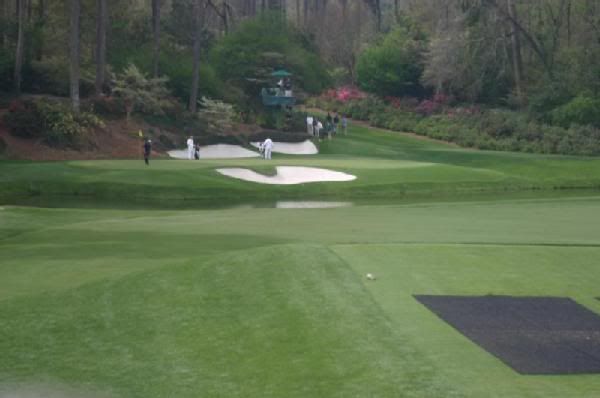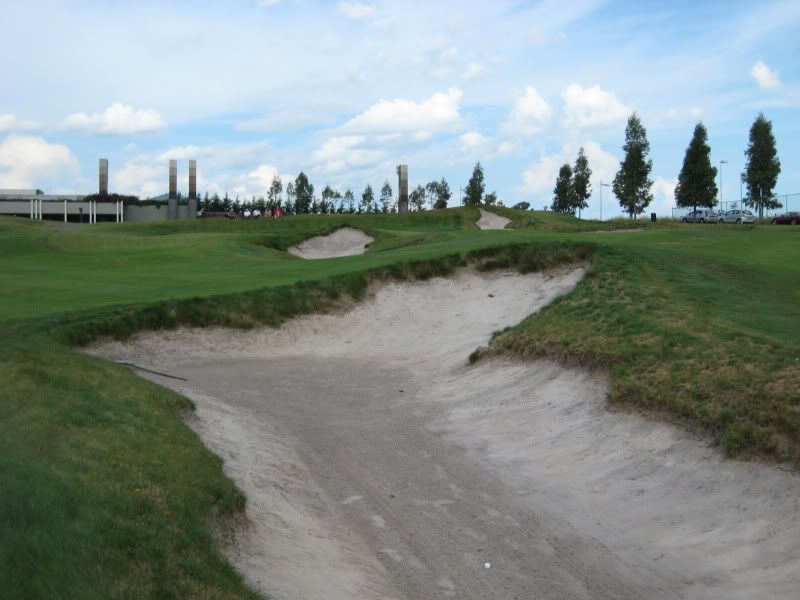The 13th is the penultimate par 3 of the day. Playing 141m, ever so slightly uphill. The large facing bunker generates an intimidating appearance to a relatively straight-forward shot. The green is artfully divided into front and back portions by a ridge which wanders through the green. Again, lots of short grass around the green, making for a broad variety of recovery options.

The next is a 341m par 4. A generous and unbunkered fairway lies in wait.

The green is hemmed in by bunkers at all four corners, necessitatng an accurate approach. Particularly if the pin is cut in the narrow section of green pinched between the two front bunkers. From the fairway, the green appears to open out at the rear, yet it drops away quite quickly. Putts played to this bigger portion of green invariably produce lengthier and more testing first putts.

The fifteenth will be judged the best hole on the course by many. An unbunkered hole, it is a 421m par 5, which features a stream wandering through the length of the hole. The fairway is expansive, and the creek can't be more than a few metres wide at most points, yet it's effect on decision making and driving is great.
Where best to go? Can I get home in two? Should I challenge the creek on the drive?

The further left the drive is played, the better the angle into the green. The portion of fairway right of the creek is more generous.
This is what you see after a reasonable drive. The creek is much further from the green front than it appears. Long approaches played from this point can fall dozens of metres short of the green and remain dry.

There's a broad lay-up area right of the green, leaving a wedge third for those who aren't long, or who didn't drive their best. This area still necessitates clearing the creek on approach, as the green's right edge is nestled hard against the water hazard. The safer / further from the creek the lay up is played, the worse the approach angle.

The green features a "scooped out" segment through much of the middle segment of the green, almost making it a Biarritz in style. It's much like the depression within the left of the new green on 11 at The Lakes. The rear of the green is a higher plateau. This makes for interesting chipping and putting, while also demanding an accurate second from the longer, more skilled golfer aiming for eagle or birdie.

This is a fun, dramatic, individual hole, where anything from 3 to 7 can be had (and was among our boys on the day). Yet another hole of real class. It owes much of it's quality to construction, as well as design skill and imagiation, as if the creek appeared synthetic, the hole would lose much of it's charm.
The 16th is the final par 3 of the day. At 125m it will be a short iron or wedge for most.
Placed innocuously on a flat, uninspiring segment of land, where one could so easily exit the 15th green, and walk to where the 17th tee sits. Yet this hole is another of quality, sits comfortably on the land, and within the routing, and is potentially of famous lineage.
The creek encountered on the previous hole meanders along, fronting the 16th green. Short grass extends from the 16th tee to the hazard. The green is quite a wide target, yet not overly deep. It sits across the axis of the hole, slightly obliquely (8 o'clock to 2 o'clock), with its surface tilted from back to front. A bunker sits at the rear of the green.
I don't think it's too much to suggest that 16 at Healesville

is a copy of a famous, slightly longer par 3 we see on TV every year.

So much of this hole plays the same.
Yet - I can't believe Clayton would be involved in a homage to the boys at Augusta National...
Looking back to the 16th tee

The seventeenth is yet another great short par 4, and at 298m will feel reachable for some. The fairway is again wide, and a lone left side fairway bunker obscures the green from view to those on the tee. But the top of the flag is visible above the hazard's top line, waving temptingly.

A direct line over the bunker is required if eagle putts are sought. Those falling short face a tricky chip, as a knoll within the left of the green repells balls to the right, and the green contours also feed off to the front and back of the putting surface.

Many golfers may elect to aim well right of the green, playing safe, into the broad fairway.

The green sits adjacent to a small scrubby rise, and is yet another with terrific undulation and fun putting.

The final hole at Healesville is a show-stopper. A 304m par 4, played from an elevated tee, into a broad valley, then up to a wild, imaginative green.

The fairway is bisected by a long, slender bunker which ascends towards the green. The left flank of the fairway is also bunkered, but transversely, presenting a carry of 220m.

Driving into the skinny central fairway bunker presents this view and a 60m uphill sand shot

The green on the home hole is amazing. A boomerang shape, with a caverous front bunker sitting in between the left and right wings of the green. A clear head is required on the tee, as drives are best placed on the same side of the fairway as the pin. The pressure is also on approach play, with great undulation and unique geometry of the green presenting it's share of challenges.


Chipping and putting from the back of the green is tougher than it looks. And putting from one wing of the green, all the way up and around the bunker, back down onto the other side of the green, is quite possible.

What a dramatic completion to the round.
RACV Healesville is a perfect template for future course design and construction. It successfully addresses so many of the ills in our game today. We lament the escalating cost of land acquisition necessitated by far flying balls and modern clubs. And the increasing time a round takes when walking modern, lengthy courses. Such layouts are costly to build, and expensive to maintain. They often aren't much fun. Especially for beginners, the aeging golfers, and the less skilled. They do little to stimulate greater participation in the sport.
Yet here is a course which was completely renovated, and shortened by around 100 yards! With a modest 38 bunkers. The greens are imaginative, fun, challenging, and unique. The fairways are wide, and several are devoid of hazards. Short grass encompasses most greens. The course is playable for all, and facets are enjoyable and stimulating for those on handicaps of 1, through to those with handicaps over 30, and even beginners. Brains are rewarded much more so than brawn. The demographic to which the course appeals may be one of the widest of all courses on Earth.
From an economic viewpoint, the shorter and sparingly bunkered course is easier to upkeep. Especially with the maintenance practices sugested by Clayton's design firm specifying simple mowing, with tees, fairways and surrounds all one height. If only this advice was followed
I can't help but think that Healesville provides an experience enjoyed by those playing Augusta National in the early days of the course's life. Exciting water hazards, boldly contoured greens with wickedly breaking putts. A course of manageable length and less bunkers than convention would dictate. Wide fairways with minimal rough, where thoughtful placement of drives was rewarded, all on a course covering picturesque undulating contryside.
Some might scoff at a par 68 course almost a mile shorter than historic local tournament venues. Yet the intelligent golfer will look at Healesville and marvel at the quality of so many holes. 5, 6, 8, 12, 15, 16, 17 and 18 are all of high calibre. Collectively, they may lift a sub-5000m par 68 course into the nation's Top 50. If offerred a game at Healesville, or any of the courses recognised as sitting around #30 to #50 in the country, I wouldn't hesitate to grab the clubs and drive to the Yarra Valley. Putting some of Melbourne's older Sandbelt clubs' noses out of joint in the process.
MatthewM